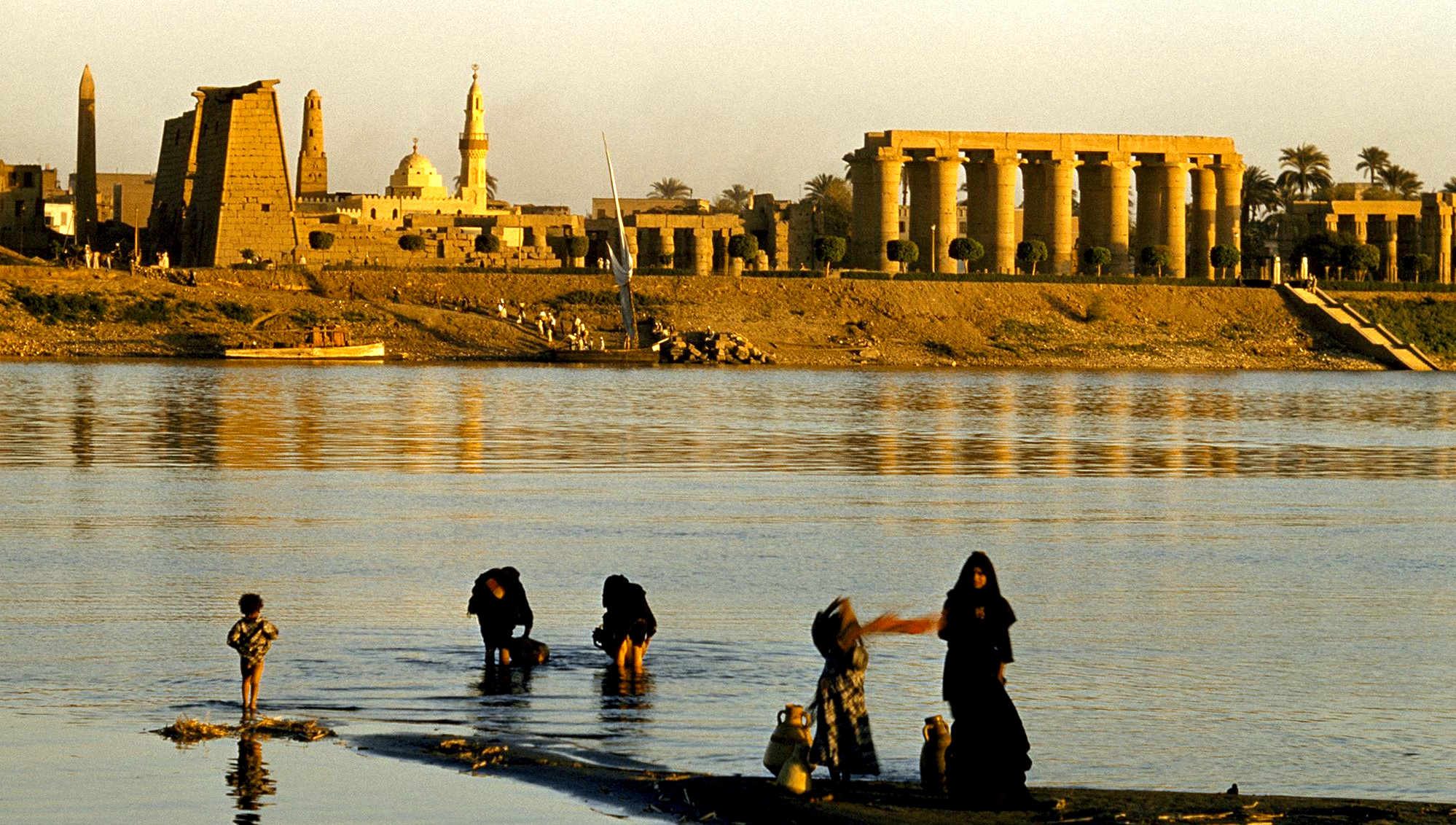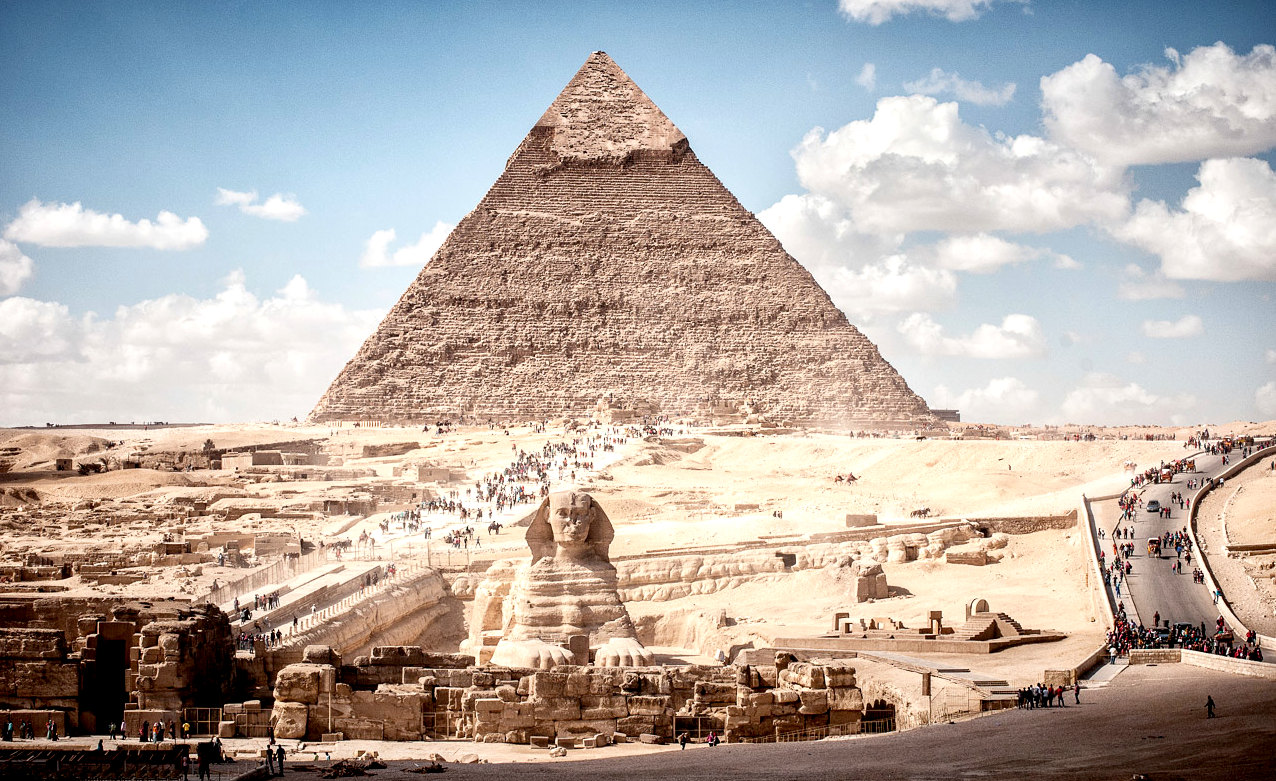
Giza
is the site of the Khafre's Pyramid, the second tallest in
Egypt.The Pyramid of Khafre or of Chephren (هرم خفرع) is the second-tallest and second-largest of the 3 Ancient Egyptian Pyramids of Giza and the tomb of the Fourth-Dynasty pharaoh Khafre (Chefren), who ruled c. 2558−2532 BC.
The pyramid has a base length of 215.5 m (706 ft) and rises up to a height of 136.4 metres (448 ft). It is made of limestone blocks weighing more than 2 tons each. The slope of the pyramid rises at a 53° 13' angle, steeper than its neighbor, the Pyramid of Khufu, which has an angle of 51°50'24". Khafre's pyramid sits on bedrock 10 m (33 ft) higher than Khufu's pyramid, which makes it appear to be taller.
The pyramid was first explored in modern times by Giovanni Belzoni on March 2, 1818, when the original entrance was found on the north side. Belzoni had hopes of finding an intact burial but the chamber was empty except for an open sarcophagus and its broken lid on the floor.
The first complete exploration was conducted by John Perring in 1837. In 1853, Auguste Mariette partially excavated Khafre's valley temple, and, in 1858, while completing its clearance, he managed to discover a diorite statue of Khafre.
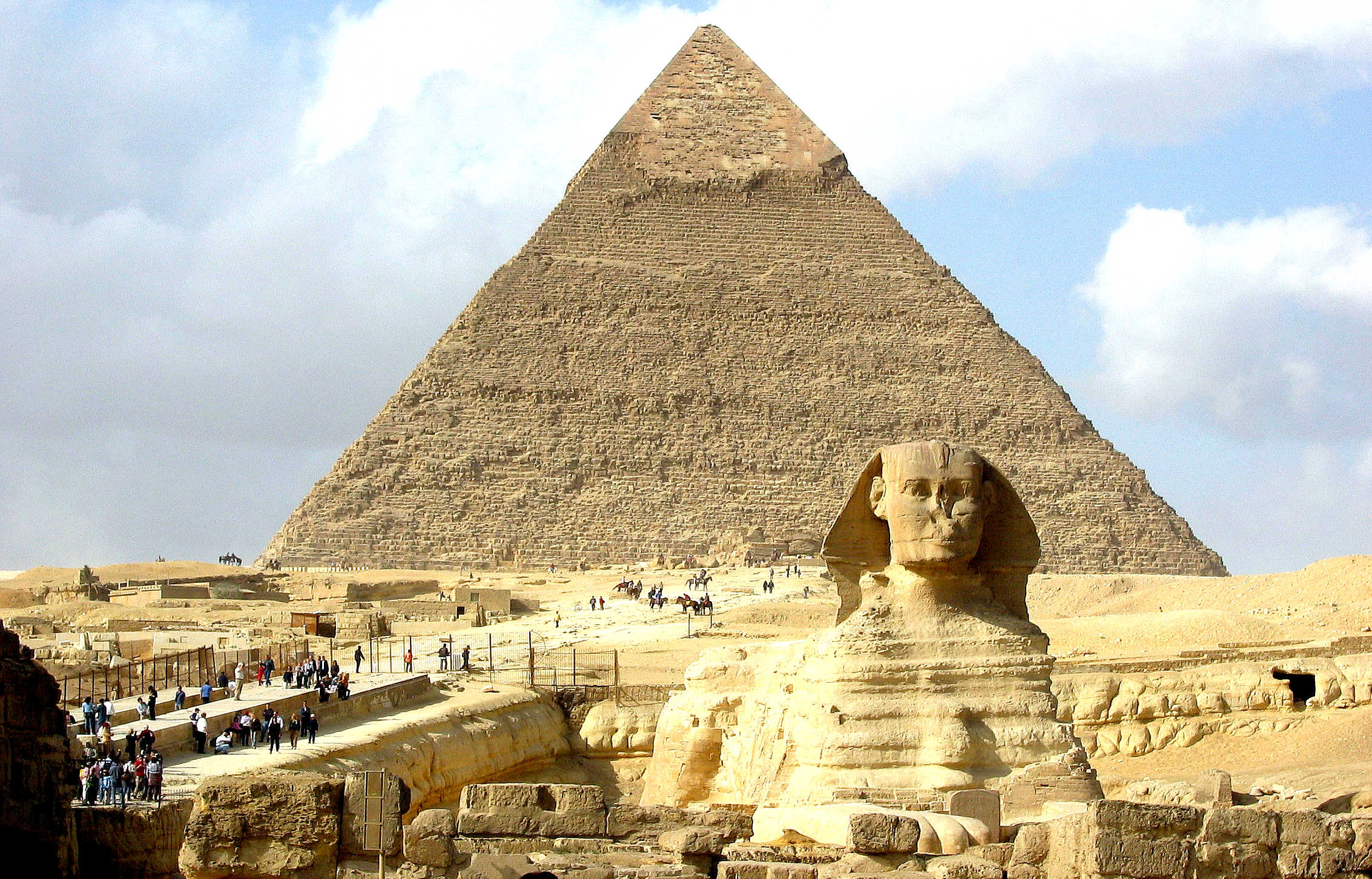
CONSTRUCTION
Like the Great Pyramid, a rock outcropping was used in the core. Due to the slope of the plateau, the northwest corner was cut 10 m (33 ft) out of the rock subsoil and the southeast corner is built up.
The pyramid is built of horizontal courses. The stones used at the bottom are very large, but as the pyramid rises, the stones become smaller, becoming only 50 cm (20 in) thick at the apex. The courses are rough and irregular for the first half of its height but a narrow band of regular masonry is clear in the midsection of the pyramid. At the northwest corner of the pyramid, the bedrock was fashioned into steps. Casing stones cover the top third of the pyramid, but the pyramidion and part of the apex are missing.
The bottom course of casing stones was made out of pink granite but the remainder of the pyramid was cased in Tura limestone. Close examination reveals that the corner edges of remaining casing stones are not completely straight, but are staggered by a few millimeters. One theory is that this is due to settling from seismic activity. An alternative theory postulates that the slope on the blocks was cut to shape before being placed due to the limited working space towards the top of the pyramid.
INTERIOR
Two entrances lead to the burial chamber, one that opens 11.54 m (37.9 ft) up the face of the pyramid and one that opens at the base of the pyramid. These passageways do not align with the centerline of the pyramid, but are offset to the east by 12 m (39 ft). The lower descending passageway is carved completely out of the bedrock, descending, running horizontal, then ascending to join the horizontal passage leading to the burial chamber.
One theory as to why there are two entrances is that the pyramid's northern base was intended to be shifted 30 m (98 ft) further to the north which would make Khafre's pyramid much larger than his father's. This would place the entrance to the lower descending passage within the masonry of the pyramid. While the bedrock is cut away farther from the pyramid on the north side than on the west side, it is not clear that there is enough room on the plateau for the enclosure wall and pyramid terrace. An alternative theory is that, as with many earlier pyramids, plans were changed and the entrance was moved midway through construction.
There is a subsidiary chamber, equal in length to the King's Chamber in Khufu's pyramid, that opens to the west of the lower passage, the purpose of which is uncertain. It may be used to store offerings, store burial equipment, or it may be a serdab chamber. The upper descending passage is clad in granite and descends to join with the horizontal passage to the burial chamber.
The burial chamber was carved out of a pit in the bedrock. The roof is constructed of gabled limestone beams. The chamber is rectangular, 14.15 by 5 m (46.4 by 16.4 ft), and is oriented east-west. Khafre's sarcophagus was carved out of a solid block of granite and sunk partially in the floor, in it, Belzoni found bones of an animal, possibly a bull. Another pit in the floor likely contained the canopic chest, its lid would have been one of the pavement slabs.
There are two small rectangular holes in the walls of the burial chamber facing each other, greatly resembling the openings of the 'air shafts' found in the Great pyramid burial chambers.
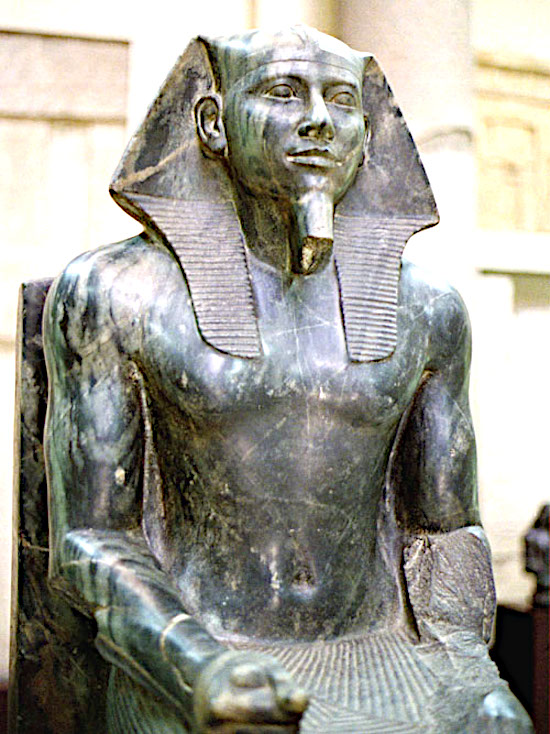
KHAFRE'S TEMPLES
The temples of Khafre's complex survive in much better condition than Khufu's, this being especially true to the Valley Temple, which is substantially preserved. To the east of the Pyramid sits the mortuary temple. Though it is now largely in ruins, enough of it survives to understand the plan. It is larger than previous temples and is the first to include all five standard elements of later mortuary temples: an entrance hall, a columned court, five niches for statues of the pharaoh, five storage chambers, and an inner sanctuary. There were over 50 life size statues of Khafre, but these were removed and recycled, possibly by Ramses II. The temple was built of megalithic blocks (the largest is an estimated 400 tonnes).
A causeway runs 494.6 metres (541 yd) to the valley temple, which is very similar to the mortuary temple. It is built of megalithic blocks sheathed in red granite. The square pillars of the T-shaped hallway were made of solid granite, and the floor was paved in alabaster. The exterior was built of huge blocks, some weighing over 100 tonnes. Though devoid of any internal decoration, this temple would have been filled with symbolism: two doors open into a vestibule and a large pillared hall, in which there were sockets in the floor that would have fixed 23 statues of Khafre. These columns have since been plundered. The interior, made of granite of the Valley Temple, is remarkably well preserved. The exterior made of limestone is much more weathered.
The so-called temple of the Sphinx is not attested to any king, but structural similarities to Khafre's mortuary temple point to him as its builder. Opening to a hall with 24 columns, each with its own statue, two sanctuaries and symmetric design, it is possible but unsure if this temple had any symbolism attached to the finished plan.
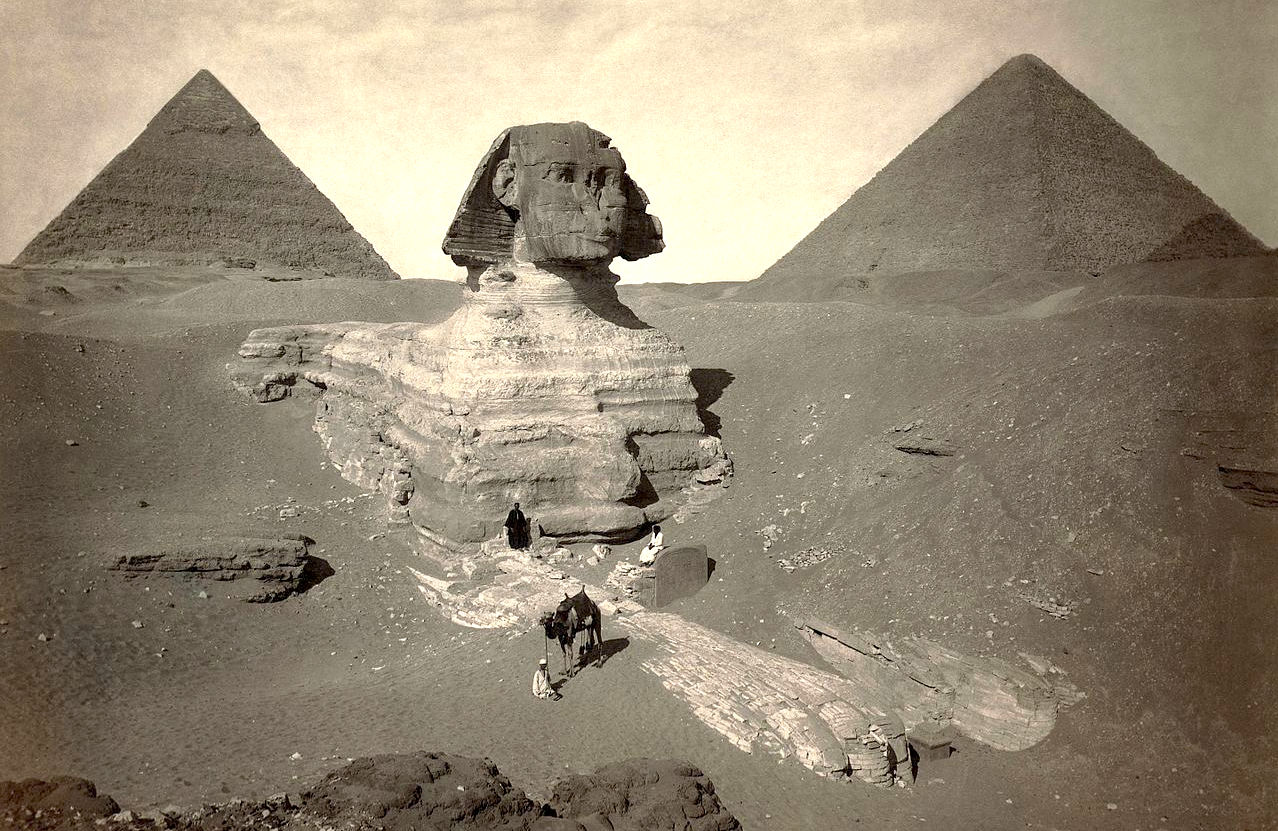
1878:
This stunning monument is
seen here swallowed by the desert sands. Who would not have wanted to lend a
hand, to allow an adoring public to see the Sphinx in all it's glory. The
Dream Stele (a granite slab between the front legs) is clearly visible.
THE GREAT SPHINX
The Great Sphinx may have been part of the complex. It was carved out of a rock formation used to cut the blocks for the pyramid itself.
Apart
from ruling their country, the
ancient Egyptians
had time to contemplate how they would cope in the afterlife
during the flooding of the Nile, when farm laborers could be
used to build, giving them a positive agenda. Each
successive ruler of the sandy kingdom, wished for more
comforts, and to outdo their forebears, in terms of how they
would be remembered.
Egypt was one of the richest and most powerful civilizations in the world
at that time. So could afford to convert their national
output, into something tangible, for their citizens to
marvel at. At the time they had few threats to national
security.
Generally,
the bigger the pyramid, the more important the Pharaoh. It's
a Freudian thing. This compendium is in order of height.
There are many very interesting pyramid designs that will be
covered in the general indexing, if they have unusual or
developmental features. Since, the art of pyramid
construction and development appears to have been an ongoing
thing, until it fizzled out as a result of resource scarcities, adventures of thieves, and land grants
to priests, as the last straw that broke the camel’s back.
Pyramids ceased to be economically viable, and a huge drain
on what we'd call the Gross National Product (GNP) today.
And as for climate
change, they are hardly a sustainable practice, in UN
SDG terms.
On
the basis that the
taller the pyramid, the higher the status of the
king or queen,
it might be argued that Khufu takes first prize, with Khafre
a close second. After that, nobody came close to 140 meters,
as the national goal to achieve a taller building than the
last ruler fell by the wayside.
Please
note, this is not a definitive table, but our own guide,
based on freely available information. Students of
archaeology and Egyptologists will draw their own
conclusions. Observations are most welcome, if we have
misquoted anything. We'd be pleased to make corrections as
applicable.

RULER
WITHOUT A PYRAMID - Tragically, queen Cleopatra poisoned herself
with an Egyptian cobra. Later her
mausoleum was washed into the sea by an earthquake and
tsunami in 365AD. Leaving little to visibly remind us of
the great Pharaoh.
The oldest known pyramid in Egypt was built around 2630 B.C. at Saqqara, for the third dynasty’s King Djoser. Known as the Step Pyramid, it began as a traditional mastaba but grew into something much more ambitious. The pyramid’s architect was Imhotep, a priest and healer who some 1,400 years later would be deified as the patron saint of scribes and physicians. Over the course of Djoser’s nearly 20-year reign, pyramid builders assembled six stepped layers of stone (as opposed to mud-brick, like most earlier tombs) that eventually reached a height of 204 feet (62 meters); it was the tallest building of its time. The Step Pyramid was surrounded by a complex of courtyards, temples and shrines where Djoser could enjoy his afterlife.
After Djoser, the stepped pyramid became the norm for royal burials, although none of those planned by his dynastic successors were completed (probably due to their relatively short reigns). The earliest tomb constructed as a “true” (smooth-sided, not stepped) pyramid was the Red Pyramid at Dahshur, one of three burial structures built for the first king of the fourth dynasty, Sneferu (2613-2589 B.C.) It was named for the color of the limestone blocks used to construct the pyramid’s core.
